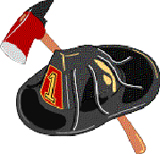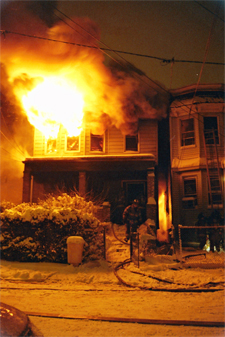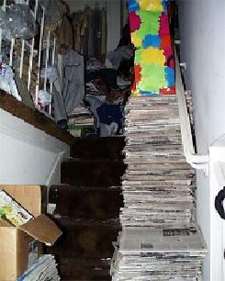Hoarding & Fire Department Operations

The quote, “one man’s trash is another man’s treasure” seems to be a fitting reference for the challenges of hoarding. Defined as a “psychological condition in which people accumulate or are unable to discard possessions”, hoarding has recently made its way to the top of the list of firefighting challenges. The difficulties and the fire departments awareness of hoarding is really NOT a new challenge. The fire service has been dealing with hoarding conditions for decades, but recent media attention from cable TV reality shows has brought the subject and its concerns to center-stage. It is for this same reason that many fire departments are taking another look at the challenges that hoarding presents.
For decades firefighters have talked of “Collyer Mansion” conditions, a reference to the wealthy and eccentric Collyer brothers who were found dead in 1947 in their mansion in NYC. Within the Brownstone style home there was an estimated 130 tons of possessions, garbage, and material which made the clean-up nearly impossible. Over the years, many of us have traded stories about responding to incidents where the inside of a particular property reflected the same story of 1947. Since that incident, the term “Collyer Mansion” has become a universal term used by many fire departments to identify the concerns within.
What follows are a few operational tips or “nuggets” for your review.
Operational tips for structure fires with Hoarding conditions:

1. En-route review:
- Review your Alarm transmission data or building list for information that a Hoarding condition exists.
- How did you get the alarm? Was it from a neighbor or someone passing by? All of which would indicate an advanced fire.
- Note the time of the alarm. Late night/early morning incidents combined with the above will indicate sleeping/unaware building occupants.
- Identify area water supply.
- Be mindful of the response times of other responding units. You are going to need to “team-up” to get things done.
2. Upon arrival:
- Establish/Name and locate Command.
- Conduct a multi-sided/360 degree view of the building.
- Size-Up incident and conduct a risk assessment.
- Give on-scene report to fire dispatch.
- Advise all that Collyer Mansion or Hoarding conditions exist.
- Request additional resources
- Determine the fires location and extent.
- Assign companies.

3. Engine Company Operations:
- Establish multiple water supplies.
- Leave room for the Ladder Company(s) placement.
- Stretch and operate 1-3/4 or 2 inch hose lines with SB nozzles to locate, confine and extinguish all fire.
- Depending upon conditions, give early consideration to teaming up two Engine Companies to stretch and operate each hose line.
- Stretch in with your TIC.
- Ensure back-up hoselines are assigned and staffed.
- Give consideration to using a “wet-water” or Class A foam operation for deep seated fires.
- Give progress reports to Command.
- Coordinate all operations with Ladder Company assignments.
4. Ladder Company Operations:
- Ensure placement is well thought out.
- Expect forcible entry and access through blocked doors and windows to be difficult.
- Place ladders everywhere!
- Report the fires location and extent.
- Coordinate VEIS (vent, entry, isolate, search) with water placement. Increased fire loads within the building combined with blocked or limited egress options will create problems.
- Be extremely mindful of where and when you “open-up”. Creating openings in and around the building will add air to the fire and create flow-paths to uninvolved areas.
- Vent opposite the push of the fire attack hoselines
- TIC is a must for reporting the fires location and occupant search.
- Report any structural concerns to Command.
- Utility control.
- Coordinate all operations with Engine Company assignments.
5. Incident Scene management considerations:
- Request additional help early.
- Assign multiple units to Fire Attack, Vent, Search and Ladders!
- Ensure RIC and Safety are in place and doing their jobs.
- Ensure members monitor SCBA-Air consumption.
- Obtain an early assessment on fire location and extent.
- Obtain an early assessment on the structural integrity of the building.
- Rotate and Rehab your members.
- Prepare to decon members and their PPE
6. After the Incident:
- Advise the occupant/tenant/landlord of the concerns
- Contact Fire Prevention
- Contact Health and Human Services
- Document the address/apt# in your pre-plan, dispatch/alarm systems.
- Leave/install a working smoke/CO detector
Stay Safe!
Mike Terpak
Deputy Chief-Jersey City
